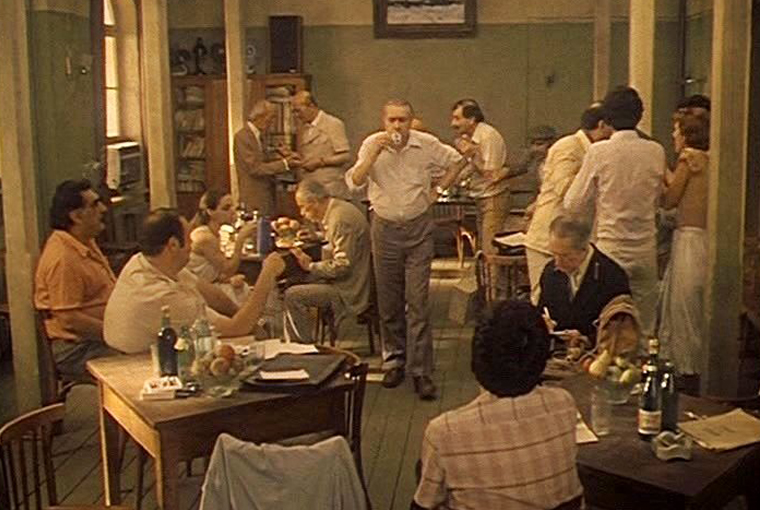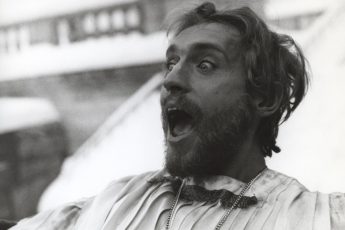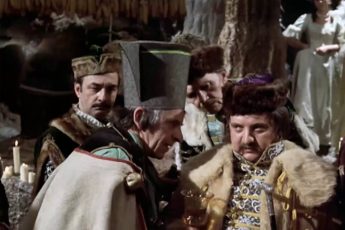Comic Timing
Eldar Shengelaia’s Blue Mountains aka An Unbelievable Story (Tsisperi mtebi anu daujerebeli ambavi, 1984)
Vol. 51 (March 2015) by Moritz Pfeifer
In Eldar Shengelaia’s Blue Mountains, writer Soso (Ramaz Giorgobiani) gets caught in the working procedures of an excessively bureaucratic publishing house when he submits his newest manuscript. Even though nobody in the publishing house is particularly opposed to the writer’s oeuvre – indeed, he seems to be on good terms with all the employees –, nobody feels responsible for getting the publishing job done. Instead, the staff spend excruciating hours discussing work plans and appointing meetings. Organizational procedures have clear priority over outcomes. Shengelaia stretches this organizational frenzy to the max, until the publishing house literally collapses and the organization moves into a loftier modern building: the ultimate victory of process over result.
Watching Blue Mountains today may no longer provoke outbursts of laughter. In fact, today’s highly competitive and result-orientated publishing houses, where production is densely controlled and quantified, may just be the nightmarish version of what Shengelaia could have considered an opposition to his bureaucratic hell. Nevertheless, the film remains a remarkably ironic observation of what happens when the procedures of a production process turn out to be more interesting than the products it creates. This seems to be the meaning of the film’s title. Soso’s manuscript is called “Blue Mountains or Tian Shan”. We never know what the manuscript is about but we know, of course, what Shengelaia’s Blue Mountains is about. Both titles have, as the organization’s director (Teimuraz Chirgadze) remarks in a running joke, “Too many titles!”, suggesting that Shengelaia’s film and the writer’s manuscript are the same.
Some commentators have called Shengelaia’s film a work of “social fiction” film, a pun on “science fiction” describing films that camouflage Socialist reality through obscuration and fantasy.1 Starting in the 1960s, with the coming-of-age of the first generation of doubters and insubordinates, such films were continuously made throughout the Communist times, provided that the political circumstances permitted it. Famous examples of “social fictions” include Jan Němec’ A Report on the Party and the Guests (1966), Krzysztof Zanussi’s Camouflage (1977), and Mircea Daneliuc’s The Cruise (1981). A common recipe for these films is to look at some social microcosm – a banquet, a university, a cruise – and use it as a metaphorical pretext to unmask the absurdities of the political macrocosm: corruption, oppression, groupism. One reason for this indirect style was that the more complex the metaphor, the more difficult it was for the censors to block a scenario (and the more gratitude for the audience for having outsmarted the system, who – unlike the censors – were sharp enough to understand the cinematographic codes of disobedience!).
Even after the fall of the Iron Curtain, many directors continued to make movies in this fashion. Elements of “social fiction” can even be found in the otherwise hyperrealist films of some Romanian New Wave directors. Corneliu Porumboiu’s 12.08 East of Bucharest is a wonderful example of a “social fiction”, in which a television show is used as a metaphor to expose the continuity of corruption, oppression, and groupism in post-Communist Romania. As a recent non-ex-Eastern Bloc example, one could mention the film Nightcrawler, an action-film-in-disguise about a freelance news reporter who leaves morals aside when he realizes that the bloodier the story, the bigger the sale. The film uses the journalistic backdrop to illustrate a larger political landscape of ruthless laissez-faire capitalism. Taking on the action-film style was risky, as many viewers quickly discredited the film as a second-rate thrill. On the other hand, this made the happy few capable of deciphering the film’s real message even merrier as they could, like in Communist times, benefit from the eureka effect separating the initiated from the duped.
There is another way of looking at these films. For what film is not a “social fiction”? Most films use a small fragment of reality to refer to a larger whole. Even Titanic, and one needn’t push the interpretation too far, is not only a love story but also a critique of Victorian England, class struggle, and of the moral responsibility the rich have for the poor. But, the difference between Cameron’s Titanic and, say, Daneliuc’s The Cruise is that, although both films scale down society to a group of boat passengers, Cameron is not obsessively trying to encode his own attitude in the situations he depicts. Differently put, Cameron’s representation of reality is descriptive. Even if it is a fictionalized, dramatized, and romanticized description, it always gives the illusion of depicting things as they were. Daneliuc’s The Cruise, on the other hand, is interpretative – like most “social fictions” and their successors. They prefer ironic commentary to reality, exposing a more personal attitude of mockery and rejection.2
Blue Mountains reveals the director’s personal attitude not only towards the specific Communist reality but also towards the Communist system’s official opinions about that reality. His film is thus echoing the kind of opinions the system is constantly expressing, but in circumstances that make it ridiculous. This use of echoic irony3 is most obvious regarding the film’s main theme of bureaucratic work environment. Take the Communist ideal of the cultured, well-educated worker. In Blue Mountains, a worker hired to paint and repair the publishing house’s walls ends up being Soso’s only loyal reader. The walls, however, get to see neither paint nor overhaul, until they finally fall apart at the end of the film. Apparently, the worker is so well-educated that he abandons work. Another example is the Communist paradigm of “full employment”. Throughout the film, an elderly man patiently waits to speak to the director. But the latter is so busy going to banquets, reunions, and other professional obligations, that the man spends a year in the waiting room until, finally, he manages to get hold of the director, who seems to have no choice but to hire him, as the applicant is acquainted with some important authority. Once hired, however, the man’s “job” pretty much consists in doing what he did all along: sitting on a chair, waiting.
Instead of directly depicting the dysfunctionality of the system, Shengelaia carefully chose a selection of opinions matching the system’s own beliefs about work. This kind of echoic irony often has a garden-path effect, causing a considerable amount of time to pass before its dissolution and final reward. One at first sees the job applicant as a realistic depiction, until one is led to the absurd conclusion that he is really looking for a job, and only then interprets the scene echoically, that is, in reference to the Communist assumption of full employment. Indeed, the irony would fall flat if, manifestly, neither the Communist doctrine nor anyone else had ever entertained the thought that there actually was full employment. By leaving the echo implicit when an addition of some explicit material would have immediately put the viewer on the right track, the director opens up a whole new line of interpretation. Most remarkably, he manages to suggest that he shares with his viewers a whole cynical vision which would have been absent from a more explicit version.
There are more subtle ironies as well, many of which regard long-lasting Georgian traditions. These ironies are not primarily echoing the system’s beliefs. They echo national traditions, which represented hope for many Georgians who thought that keeping social and artistic conventions alive was a counter-cultural gesture against the atheist and ahistorical mode of Communism. In his older films, which often depict singing, music, celebration, and poetry, Shengelaia could have easily be considered to believe that national survival would outshine Communist rule (see An Unusual Exhibition). Not so in Blue Mountains. Poetry, which used to be central to the director’s artistic preferences, is here reduced to a collection of verses the chairman of a “moto-ball” club hands over to the director. Shengalaia’s head-on aesthetics in Blue Mountains can also be seen as self-criticism of his older, more poetically inspired work. But poetry is not the only tradition Shengelaia deconstructs. As film scholar Julie Christensen observes, in Blue Mountains, “Banquets, so important to Georgian cultural tradition, give administrators heartburn, and the overflowing bounty of the Georgian table is replaced by the director’s refrigerator cum mineral water and the single egg that another editor [from the publishing house], Irodin, fusses over and hides in his otherwise empty safe.”4 Most importantly though, these symbolic details follow the same kind of irony Shengelaia used against the larger Communist ideals. Here as well, it is not so much the traditions themselves that are made fun of, but the opinion people, including Shengelaia, might have had about these traditions and the ridiculousness of pretending to keep them alive in a context from which they have long disappeared. The irony is also again a solidary irony, as viewers may only share Shengelaia’s attitude of mockery once they have understood the opinions it is echoing.
Note that this kind of echoic irony bears some resemblance to the famous incongruity theory of humor (propagated, among others, by Kant, Bergson, and even Freud) which states that humor is perceived when one realizes the incongruity between a concept (e.g. full employment) and some real-life application of that concept (e.g. an employee who doesn’t work). As mentioned above, I wouldn’t suggest that Blue Mountains is strictly speaking funny to watch. Nevertheless, the film’s use of irony has some interesting implications concerning comic timing. Since it takes basically the whole movie until the viewer can make sense of its ironic instances – until the incongruities are resolved -, one reason why it might not strike the viewer as a genuine comedy is because the film over-stretches the viewer’s comic attention span. The pleasure of knowing that the joke will snap is already gone the moment it does.
Or, is it? Perhaps the films comic moments just need more time to be registered. So much so, that the movie has the strange characteristic of becoming funnier over time. This peculiar phenomenon seems to agree with the fact that some of the film’s lines have made it into Georgian everyday language and are still used by the generation of moviegoers of the 1980s. Thus the film opens with one of the workers trying to rid himself of a painting of Greenland that he fears might fall off the wall and possibly on his head. But, of course, this simple task cannot just be executed. Request forms have to be formulated, meetings have to be held, and signatures are needed… “Take it away” (“gaitanet”) has since become a popular saying whenever one wants to get rid of something. Another joke was created out of a worker whose French lessons keep him from doing his job. He speaks French to all of his colleagues and in one scene, another colleague – asked about his well-being – actually replies with “comme si comme ça, my dear Shukri (“comme si comme ca, chemo Shukri”). Both of these jokes need time to fulfill their comic purpose. The film first has to build up the necessary premises or opinion for the viewer to understand them. For the painting the ironic resolution lies in the realization that there are people who believe that it is bureaucratically possible to change things. For the French sentence the irony is a bit more complicated. It regards respect for the Georgian language, which the film reduces to empty formulas: forms of language are more important than their pragmatic use. This is yet again a variation of the film’s main theme: the dominance organizational processes have over results. The meaning of having two workers converse politely in a foreign language shows their resolute belief in proper etiquette, so devoid of any meaning that they may as well speak French.
The afterlife of these and other jokes in Blue Mountain is an indication for their belated comical effect. Indeed, they lack the characteristics of most jokes: resolving them does not grant immediate gratification. The viewer needs time to reassemble and decode the opinions they echo. But once this is done, the viewer is granted a rather pleasurable reward. As Simon Critchley, one of the few contemporary philosophers out there to have continued the humor-thinking tradition, observes: “Viewed temporally, humorous pleasure would seem to be produced by the disjunction between the duration and the instant, where we experience with renewed intensity both the slow passing of time and its sheer evanescence.”5 The comic timing of Blue Mountains is postponed precisely because the interval between the experience and its renewed intensity is so large. But once the echoic ironies are resolved, the film must have granted the audience true joy, all the more so because they must have felt that they were not supposed to find the film very funny. And what is more fun than laughing at something without it being aware?




Leave a Comment